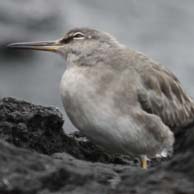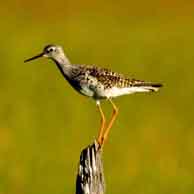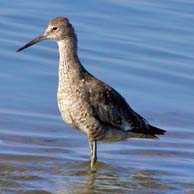Tringa is a genus of waders, containing the shanks and tattlers. They are mainly freshwater birds, often with brightly colored legs as reflected in the English names of six species, as well as the specific names of two of these and the green sandpiper. They are typically associated with northern hemisphere temperate regions for breeding. Some of this group — notably the green sandpiper — nest in trees, using the old nests of other birds, usually thrushes.
The willet and the tattlers have been found to belong in Tringa; these genus changes were formally adopted by the American Ornithologists' Union in 2006.
The present genus in the old, more limited sense was even further subdivided into Tringa proper and Totanus, either as subgenera or as full genera. The available DNA sequence data suggests however that neither of these is monophyletic and that the latter simply lumps together a number of more of less closely related apomorphic species. Therefore it seems unwarranted to recognize Totanus even as a subgenus for the time being.
Green sandpiper, Tringa ochropus
Solitary sandpiper, Tringa solitaria
Grey-tailed tattler, Tringa brevipes - formerly Heteroscelus brevipes
Wandering tattler, Tringa incana - formerly Heteroscelus incanus
Spotted redshank, Tringa erythropus
Greater yellowlegs, Tringa melanoleuca
Common greenshank, Tringa nebularia
Willet, Tringa semipalmata - formerly Catoptrophorus semipalmatus
Lesser yellowlegs, Tringa flavipes
Nordmann's greenshank, Tringa guttifer
Marsh sandpiper, Tringa stagnatilis
Common redshank, Tringa totanus
Wood sandpiper, Tringa glareola

ComingsBirds.com/Birdgroups S-Z
To the Beauty of Birds

- Home
- SALTATORS (2)
- SANDGROUSE (3)
- SANDPIPERS (11)
- SADDLEBACK (1)
- SAPSUCKERS (1)
- SCREAMERS (1)
- SCRUB-ROBIN (1)
- SECRETARY BIRDS (1)
- SEEDEATERS (9)
- SEEDSNIPES (1)
- SERIEMAS (1)
- SHAMA THRUSH (2)
- SHEARWATERS (4)
- SHEATHBILLS
- SHRIKES (3)
- SISKINS (4)
- SKIMMERS (1)
- SKUAS (2)
- SNIPE (1)
- SPARROWS A-O (14)
- SPARROWS O-Z (9)
- SPINETAILS (2)
- SPOONBILLS (3)
- STARLINGS (13)
- STILTS (5)
- STORKS (8)
- SUNBIRDS (13)
- SUNBITTERNS (1)
- SWANS (4)
- SWALLOWS/MARTINS A-R (11)
- SWALLOWS/MARTINS S-Z (6)
- SWIFTS (2)
- TANAGERS A-G (10)
- TANAGERS H-Z (11)
- TATTALERS AND SHANKS (6)
- TEALS (11)
- TERNS (13)
- THICK-KNEES (4)
- THRASHERS (2)
- THRUSHES A-Q (12)
- THRUSHES R-Z (4)
- TITMICE (4)
- TOUCANS (4)
- TOWHEES (4)
- TREERUNNERS (1)
- TROGANS (11)
- TROPICBIRDS (2)
- TRUMPETERS (1)
- TURACOS (8)
- TURKEYS (2)
- TURNSTONE (2)
- VERDINS (1)
- VIREO (4)
- VULTURES/CONDORS (11)
- WAGTAILS (4)
- WARBLERS NEW WORLD A-B (10)
- WARBLERS NEW WORLD C-N (11)
- WARBLERS NEW WORLD O-Z (11)
- WAXBILLS (4)
- WAXWINGS (1)
- WEAVERS (9) A-H
- WEAVERS (11) I-S
- WEAVERS (5) T-Z
- WEAVER FINCHES (1)
- WHEATEARS (2)
- WHITEYES (5)
- WHISTLERS (2)
- WHYDAHS (1)
- WIDOWBIRDS (6)
- WOODCOCKS (1)
- WOODCREEPERS (3)
- WOODPECKERS (14) A-N
- WOODPECKERS (5) O-Z
- WOODSWALLOWS (1)
- WRENS (10)
- template



© 2010 David Comings Contact Me